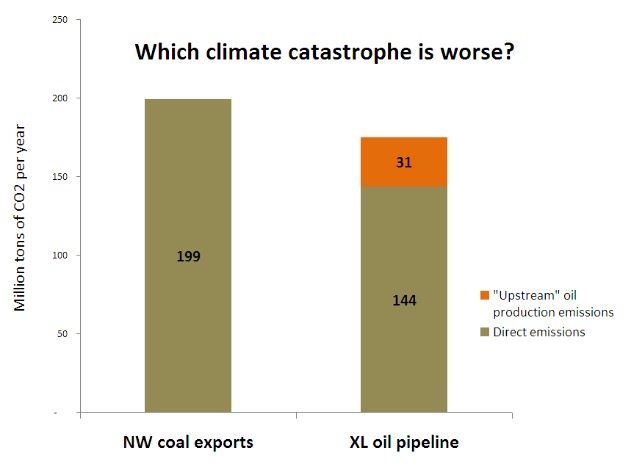This post originally appeared on Sightline Daily.
The planned Keystone XL oil pipeline has earned major national attention for the damage it would do to the climate. At the same time, another climate drama is playing out with much less attention as coal companies make plans to export huge quantities to Asia by way of Pacific Northwest ports. It’s pretty clear that both projects are environmental horror stories, but I’ve been wondering: Which one is worse?
So, from the King Kong versus Godzilla files, here’s my analysis of their carbon impacts.

The result surprised me: Coal exports look to be an even bigger climate disaster than the pipeline. There are, in fact, quite a bit more direct emissions from burning the coal than from the oil. That’s true even when one counts the energy-intensive tar-sands extraction and processing — and, of course, there are plenty of upstream emissions associated with coal mining that I’ve left out of the equation here. (In order to make a roughly direct comparison, I also omitted emissions associated with both products’ mining, refining, transportation, and so forth.) Clearly we can ill afford either one of these projects, but until we have a clear energy policy that respects climate science we’ll be wrestling with these kind of killer projects one at a time.
Now, for all the energy and math geeks out there, here’s the methodology I used to generate these numbers.
To calculate the carbon-dioxide emissions from coal exports, I assumed that 110 million tons of Powder River Basin coal are exported each year. That’s consistent with the 50 million tons planned for Cherry Point, Wash., and 60 million tons planned for Longview, Wash. (It’s a figure that may actually understate the actual volume of exports because the Longview project sponsors have already been caught out using an 80 million ton figure, and there are nascent or rumored coal export plans that I didn’t account for in places like Grays Harbor, Wash.; St. Helens, Ore.; and Coos Bay, Ore.) I further assumed that Powder River Basin coal generates 8,500 BTUs per pound, and that 1 million BTUs would produce 212.7 pounds of CO2, consistent with U.S. Department of Energy figures. Do all the algebra, and you arrive at 199 million tons of CO2 per year in “direct” emissions from the coal exports.
My coal emissions accounting leaves out a lot. I did not count the emissions associated with mining, processing, rail shipping, storing, maritime shipping, constructing new port or rail facilities, or any other related activities. I also didn’t count any non-CO2 or fugitive emissions. All I counted, in short, was the CO2 that will be directly released by burning the coal.
To calculate the CO2 emissions from the Keystone XL pipeline, I assumed that the pipeline moves 830,000 barrels of oil per day, which is what the U.S. State Department says, and which works out to about 303 million barrels per year. I then assumed that each barrel of oil contains 0.43 metric tons of C02, which is what the U.S. EPA assigns for an “average” barrel of oil. That all works out to just shy of 144 million short tons of CO2 per year for direct emissions from burning the oil.
The pipeline will not be moving “average” oil, of course, but rather tar-sands oil, which is especially dirty and carbon intensive. Keep in mind, however, that “tailpipe” or direct emissions for the refined products that come from the oil — gasoline, diesel, kerosene, etc. — are basically the same no matter what the original feedstock is. In other words, every gallon of gasoline you burn in your car produces pretty much the same amount of CO2 whether it originally came from Saudi Arabia, the Gulf Coast, or the Canadian oil sands.
The difference is that it takes a lot more energy, and therefore carbon, to extract and process tar-sands oil. So to account for the special nastiness of tar-sands oil, I factored in the emissions that are associated with “producing” or extracting it. Using figures from David Strahan, Wikipedia, and other sources, I assumed that extracting the oil and “upgrading” to make it suitable for refining results in somewhere around 18 to 26 percent more carbon emissions than the direct emissions from burning the fuel itself. (The exact amount depends on the local characteristics of the oil deposit as well as the technology deployed and other factors.) I took the mid-point of that range, 21.7 percent, and added 31 million tons of CO2 per year for the pipeline oil.
To maintain a roughly apples-to-apples comparison with my coal emissions calculation, I didn’t factor in emissions from shipping, refining, distributing, constructing the pipeline, or any other related activities. And again, I didn’t count any non-CO2 or fugitive emissions. All I counted, in short, was the CO2 that will be directly released by burning the oil plus the emissions required to extract and process the oil from the tar-sands deposits.
Comments and suggestions (and corrections) are of course very welcome. Thanks to Jessie Dye at Earth Ministry who prompted me to do this analysis.



